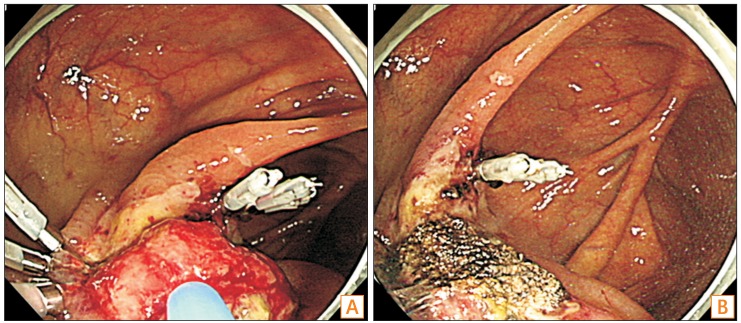Intest Res.
2017 Apr;15(2):221-227. 10.5217/ir.2017.15.2.221.
Clinical outcome of endoscopic management in delayed postpolypectomy bleeding
- Affiliations
-
- 1Department of Gastroenterology, Asan Medical Center, University of Ulsan College of Medicine, Seoul, Korea. jsbyeon@amc.seoul.kr
- KMID: 2425165
- DOI: http://doi.org/10.5217/ir.2017.15.2.221
Abstract
- BACKGROUND/AIMS
The clinical course after endoscopic management of delayed postpolypectomy bleeding (DPPB) has not been clearly determined. This study aimed to assess clinical outcomes after endoscopic hemostasis of DPPB and evaluate risk factors for rebleeding after initial hemostasis.
METHODS
We reviewed medical records of 198 patients who developed DPPB and underwent endoscopic hemostasis between January 2010 and February 2015. The performance of endoscopic hemostasis was assessed. Rebleeding negative and positive patients were compared.
RESULTS
DPPB developed 1.4±1.6 days after colonoscopic polypectomy. All patients achieved initial hemostasis. Clipping was the most commonly used technique. Of 198 DPPB patients, 15 (7.6%) had rebleeding 3.3±2.5 days after initial hemostasis. The number of clips required for hemostasis was higher in the rebleeding positive group (3.2±1.6 vs. 4.2±1.9, P=0.047). Combinations of clipping with other modalities such as injection methods were more common in the rebleeding positive group (67/291, 23.0% vs. 12/17, 70.6%; P<0.001). Multivariate analysis showed a large number of clips and combination therapy were independent risk factors for rebleeding. All the rebleeding cases were successfully managed by repeat endoscopic hemostasis.
CONCLUSIONS
Endoscopic hemostasis is effective for the management of DPPB because of its high initial hemostasis rate and low rebleeding rate. Endoscopists should carefully observe patients in whom a large number of clips and/or combination therapy have been used to manage DPPB because these may be related to the severity of DPPB and a higher risk of rebleeding.
Keyword
MeSH Terms
Figure
Reference
-
1. Citarda F, Tomaselli G, Capocaccia R, Barcherini S, Crespi M. Italian Multicentre Study Group. Efficacy in standard clinical practice of colonoscopic polypectomy in reducing colorectal cancer incidence. Gut. 2001; 48:812–815. PMID: 11358901.
Article2. Winawer SJ, Zauber AG, Ho MN, et al. Prevention of colorectal cancer by colonoscopic polypectomy: the National Polyp Study Workgroup. N Engl J Med. 1993; 329:1977–1981. PMID: 8247072.
Article3. Thiis-Evensen E, Hoff GS, Sauar J, Langmark F, Majak BM, Vatn MH. Population-based surveillance by colonoscopy: effect on the incidence of colorectal cancer. Telemark Polyp Study I. Scand J Gastroenterol. 1999; 34:414–420. PMID: 10365903.
Article4. Dominitz JA, Eisen GM, Baron TH, et al. Complications of colonoscopy. Gastrointest Endosc. 2003; 57:441–445. PMID: 12665750.
Article5. Waye JD, Kahn O, Auerbach ME. Complications of colonoscopy and flexible sigmoidoscopy. Gastrointest Endosc Clin N Am. 1996; 6:343–377. PMID: 8673332.
Article6. Waye JD, Lewis BS, Yessayan S. Colonoscopy: a prospective report of complications. J Clin Gastroenterol. 1992; 15:347–351. PMID: 1294644.7. Gibbs DH, Opelka FG, Beck DE, Hicks TC, Timmcke AE, Gathright JB Jr. Postpolypectomy colonic hemorrhage. Dis Colon Rectum. 1996; 39:806–810. PMID: 8674375.
Article8. Rosen L, Bub DS, Reed JF 3rd, Nastasee SA. Hemorrhage following colonoscopic polypectomy. Dis Colon Rectum. 1993; 36:1126–1131. PMID: 8253009.
Article9. Sorbi D, Norton I, Conio M, Balm R, Zinsmeister A, Gostout CJ. Postpolypectomy lower GI bleeding: descriptive analysis. Gastrointest Endosc. 2000; 51:690–696. PMID: 10840301.
Article10. Levin TR, Zhao W, Conell C, et al. Complications of colonoscopy in an integrated health care delivery system. Ann Intern Med. 2006; 145:880–886. PMID: 17179057.
Article11. Uno Y, Satoh K, Tuji K, et al. Endoscopic ligation by means of clip and detachable snare for management of colonic postpolypectomy hemorrhage. Gastrointest Endosc. 1999; 49:113–115. PMID: 9869736.
Article12. Kwon MJ, Kim YS, Bae SI, et al. Risk factors for delayed post-polypectomy bleeding. Intest Res. 2015; 13:160–165. PMID: 25932001.
Article13. Parra-Blanco A, Kaminaga N, Kojima T, et al. Hemoclipping for postpolypectomy and postbiopsy colonic bleeding. Gastrointest Endosc. 2000; 51:37–41. PMID: 10625793.
Article14. Binmoeller KF, Thonke F, Soehendra N. Endoscopic hemoclip treatment for gastrointestinal bleeding. Endoscopy. 1993; 25:167–170. PMID: 8491134.
Article15. Maiss J, Dumser C, Zopf Y, et al. “Hemodynamic efficacy” of two endoscopic clip devices used in the treatment of bleeding vessels, tested in an experimental setting using the compact Erlangen Active Simulator for Interventional Endoscopy (compactEASIE) training model. Endoscopy. 2006; 38:575–580. PMID: 16802269.
Article16. Baillie J. Postpolypectomy bleeding. Am J Gastroenterol. 2007; 102:1151–1153. PMID: 17531008.
Article17. Choung BS, Kim SH, Ahn DS, et al. Incidence and risk factors of delayed postpolypectomy bleeding: a retrospective cohort study. J Clin Gastroenterol. 2014; 48:784–789. PMID: 24231934.



